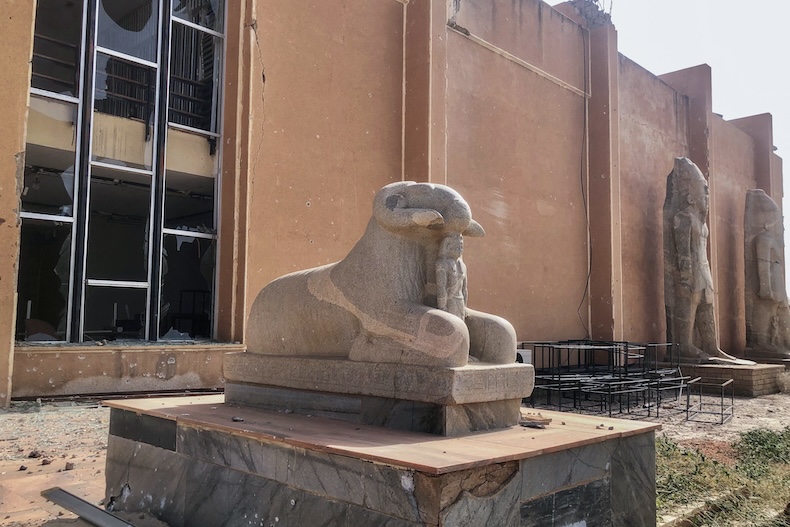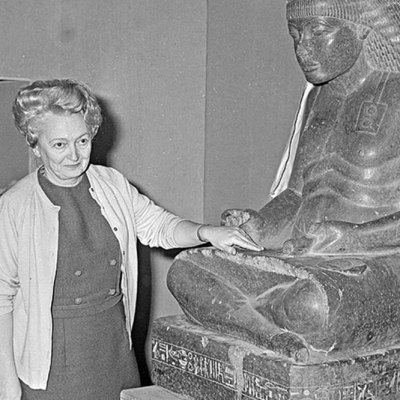At the end of March, the forces of the Sudanese government recaptured Khartoum and photographs emerged showing looting of the Sudan National Museum. The Rapid Support Forces (RSF) – a paramilitary group fighting the Sudanese army – have ransacked the museum, while the ongoing conflict has caused damage to various monuments, including entire temples and tombs preserved in the museum’s outdoor areas.
The Sudan National Museum is the most significant museum in the country. Its importance lies not only in the fact that it houses the largest collection of Nubian objects in the world, but also in the cultural and historical significance of its collections. These collections attest to the long history of Sudan – home to Kerma, one of the earliest African states – and also to the resilience of Sudanese heritage. Despite major threats to its preservation in recent history, Sudan’s heritage continues to hold a vital place in the country’s cultural landscape.
Remains of the temple of Buhen in January 2018. Photo: Rennan Lemos

Preservation challenges have largely stemmed from several dam projects along the Nile, ranging from the Aswan Low Dam, which was built in 1902, then heightened in 1907 and 1912, to the Aswan High Dam, which was created in 1970, and the more recent Merowe Dam of 2009. These dam projects have meant that Nubia is one of the most thoroughly documented archaeological regions in the world. Between 1960 and 1980, the UNESCO International Campaign to Save the Monuments of Nubia led efforts to document numerous sites, as well as to relocate entire temples and tombs from Egyptian and Sudanese Lower Nubia – an area that was to be flooded during the construction of the Aswan High Dam.
A significant portion of the Sudan National Museum’s collection stems from the UNESCO campaign and other initiatives to salvage artefacts in Sudanese Nubia. Various monuments from now-submerged sites were dismantled at their original locations before being reassembled at the museum. These efforts are consistent with much of the country’s recent history, which has involved great loss, the displacement of local communities and the severing of their cultural ties to ancestral landscapes. But such initiatives are also remarkable acts of preservation.
Statue of Amun in the form of a ram, protecting king Taharqa from the Temple of Kawa, standing outside the Sudan National Museum in April 2025. Photo: AFP

The ongoing war, which broke out in April 2023, is undoing those efforts. Archaeological sites in the north of the country – to where many have fled seeking safety from a war in which an estimated 150,000 people have died, millions have been displaced and millions are starving – are now under increased pressure. The looting of the Sudan National Museum is the most striking example of the destruction of cultural heritage. Dramatic images of the remains of the temple of Buhen, rescued during the UNESCO campaign and brought to the museum, suggest that they have been damaged, while photos from inside the museum reveal the extent of the RSF’s destructive actions.
Nineteenth-century travellers to Sudan helped spark early Western interest in the country’s past. Extensive archaeological exploration took place during the colonial period, while the largest salvage excavations, especially those in the 1960s and ’70s, contributed to the formation of large collections of artefacts ranging from the Palaeolithic period to Medieval times. The museum’s collection includes significant items such as a colossal statue, from Jebel Barkal, of Taharqa, one of the most important Kushite kings who also ruled over Egypt in the seventh century BC; and the Faras Cathedral wall paintings – unique examples of medieval Christian art from north-east Africa.
Remains of the temple of Buhen as they are in April 2025. Photo: AFP

While the UNESCO campaign focused on the rescue of Egyptian temples such as Abu Simbel, temples and tombs from the north of Sudan were also saved. As well as Buhen, the temples of Semna and Kumma are also preserved at the Sudan National Museum, while other monumental remains can be found in the museum’s gardens, including a decorated wall from the temple of Aksha, walls with rock inscriptions, Kushite colossal statues and columns from Faras Cathedral. The earliest painted rock-cut tomb in Sudan – the tomb of Djehutyhotep, a local chief who lived during the reign of Hatshepsut and Thutmose III in the 15th century BC – was also rebuilt in the museum’s garden. Though the damage to the temple of Buhen has been documented, it is currently unclear to what extent the other structures have been affected.
Today, as in the past, Sudanese heritage professionals are working to protect archaeological sites and museum collections. Their resilience has become a vital part of Sudanese heritage itself. Thanks to their dedication – and, it is to be hoped, broad international support – Sudan’s historical legacy will continue to be a central part of its cultural identity.
Rennan Lemos teaches Egyptian and Sudanese archaeology at the University of Cambridge and is assistant director of the Sanam Temple Project, having led excavations at the temple of Taharqa.



